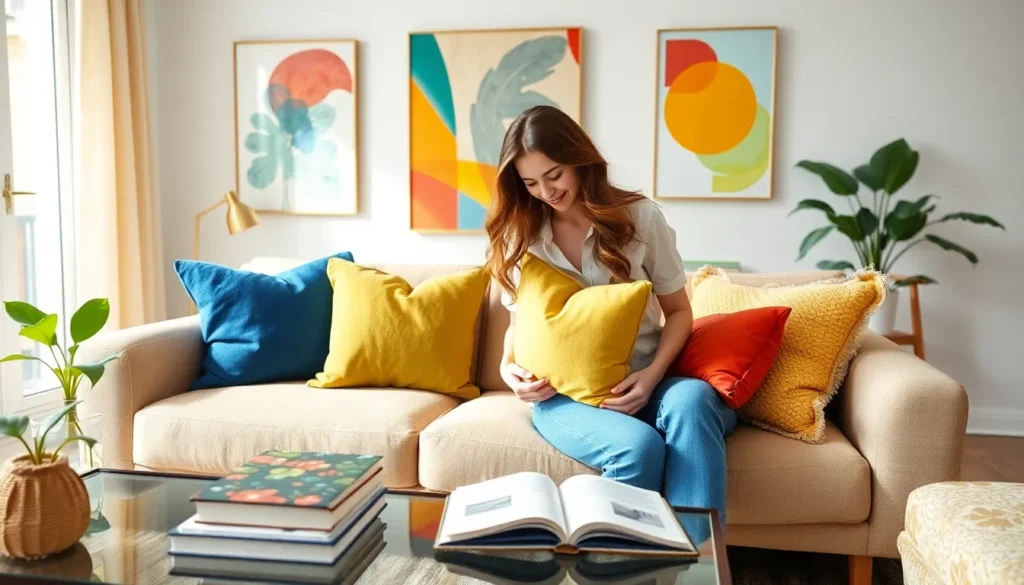Creating stunning design and decor isn’t just for the professionals; it’s for anyone who wants their space to feel like a million bucks without spending it. Imagine transforming a dull room into a vibrant oasis that sparks joy and maybe even a little envy from the neighbors. With the right tips and tricks, anyone can channel their inner designer and create a space that reflects their personality.
Table of Contents
ToggleUnderstanding Design and Decor
Understanding design and decor enhances the appeal and functionality of any space. Design involves planning and creating a cohesive layout, while decor focuses on embellishments that express one’s personality.
Importance of Design in Spaces
Design significantly impacts how individuals experience a space. A well-designed layout optimizes functionality, guiding movement and interaction. It promotes comfort and efficiency, ensuring spaces meet the needs of users. Aesthetics also play a crucial role; visually appealing designs can boost mood and inspire creativity. Research indicates that thoughtfully designed areas enhance productivity and well-being, demonstrating the transformative power of good design.
Differentiating Design and Decor
Design and decor, while interrelated, serve distinct purposes. Design encompasses the overall layout, structure, and flow of a space. It considers elements such as space planning, color schemes, and architectural features. Decor, on the other hand, focuses on stylistic choices like furniture, accessories, and art. Personal preferences emerge in decor, allowing individuals to express their unique tastes. Understanding this distinction helps individuals create spaces that seamlessly blend functionality with personal style.
Steps to Create Design and Decor

Creating design and decor involves clear steps that guide individuals towards their vision. Understanding these steps helps everyone achieve captivating interiors.
Establishing a Vision
Establishing a vision starts the design process. Individuals should consider the purpose of the space and the desired atmosphere. Think about personal styles and inspirations. Reviewing magazines, online platforms, and social media can spark creativity. Gathering images that resonate can help form a cohesive vision. Setting specific goals for functionality and aesthetics ensures clarity throughout the project. Prioritizing elements that matter most allows for focused decision-making, which leads to effective design outcomes.
Selecting a Color Palette
Selecting a color palette plays a crucial role in establishing mood and harmony. Individuals should choose colors that complement their vision. Consider the emotional impact of colors when making decisions. Neutral shades can create a tranquil environment, while bold colors add energy and excitement. Collecting color samples and testing them in different lighting helps visualize the final look. A color wheel can assist in understanding color relationships and choosing complementary colors. Finalizing a palette of two to five colors can create a cohesive and visually appealing space.
Furniture and Layout
Furniture selection and layout significantly influence the overall design and decor of a space. Effective choices enhance comfort, style, and practicality.
Choosing the Right Furniture
Selecting the right furniture involves considering the room’s function and available space. Prioritize choosing pieces that fit the scale of the room, ensuring a balanced appearance. Opt for multi-functional items like storage ottomans or extendable tables to make the most of limited space. Identify a central theme or style, such as modern, rustic, or eclectic, to ensure cohesive furniture choices. Test comfort levels and usability before purchasing, as these factors contribute to overall satisfaction.
Arranging for Flow and Functionality
Arranging furniture for optimal flow promotes ease of movement throughout the space. Start by creating conversation areas with seating that encourages interaction. Position larger furniture pieces against walls to free up floor space. Consider the flow of traffic; paths should remain clear and accessible. Evaluate the placement of tables and chairs to maximize functionality, allowing for easy access to essentials. Finally, incorporate personal touches, such as art or plants, to create an inviting atmosphere while maintaining practicality.
Personal Touches in Design
Personal touches elevate design, making spaces feel unique and reflective of individual tastes. Incorporating these elements enhances a room’s character and warmth.
Incorporating Personal Style
Highlighting personal style transforms any space into a true reflection of oneself. Each person’s interests play a crucial role; artwork, photographs, and mementos can bring beloved memories into view. Selecting items that resonate personally establishes a narrative within the space. Incorporating heritage pieces, favorite colors, or distinctive shapes also contributes to a cohesive design. It’s essential to balance personal flair with overall design principles to maintain aesthetic harmony.
Adding Textures and Patterns
Textures and patterns bring depth and life to environments. Blending different materials, such as wood, metal, and fabrics, adds tactile interest. Layering textiles like cushions or throws fosters comfort and warmth. Introducing patterns through rugs or wall art enhances visual engagement; geometric designs, florals, or abstract prints serve as excellent options. Ensuring that these elements harmonize with the color palette strengthens the overall aesthetic. Thoughtful layering of textures and patterns transforms the ambiance of any room.
Creating stunning design and decor is within reach for everyone. With a clear vision and thoughtful planning anyone can transform their space into a reflection of their personality. By understanding the balance between design and decor individuals can enhance both the aesthetic and functionality of their homes.
Emphasizing personal touches and the right furniture choices can elevate any room. Incorporating textures and patterns adds depth and warmth while ensuring a harmonious flow throughout the space. With these insights and practical steps anyone can embark on their design journey and create an inviting atmosphere that truly feels like home.



